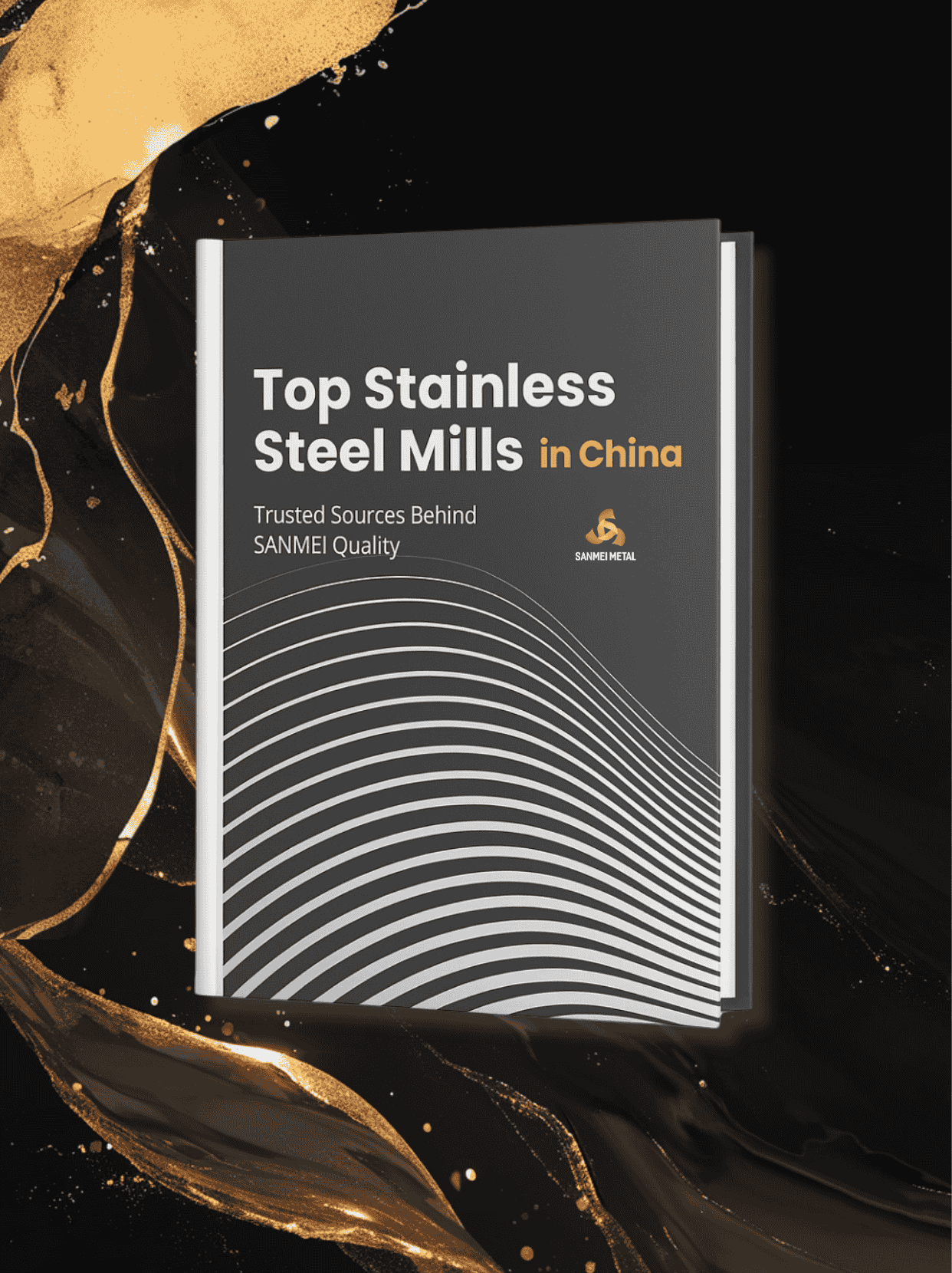
Get Your FREE Access: China’s #1 Steel Mill Dossier
Buyer-Oriented: Match mills by grade/finish/width-thickness/application
BAOWUTsingshanLiscoTisco


304 Stainless Steel Equivalent to the Following Items
| 1.4301 | ASTM 304 Stainless Steel | G4303 | 18/8 Stainless Steel |
| S30400 Stainless Steel | T 304=Type 304 Stainless Steel | 304 SS | SAE 304 Stainless Steel |
| 304 Grade Stainless Steel | SUS 304 Stainless Steel | UNS S30400 Stainless Steel |
All these names and designations refer to the same type of austenitic stainless steel with 18% chromium and 8% nickel, commonly known as 304 stainless steel. This material is widely used in various applications due to its excellent corrosion resistance and relatively good mechanical properties.
Corrosion Resistance of 304 Stainless Steel
Due to its high nickel content, 304 stainless steel exhibits excellent corrosion resistance. However, its resistance to saltwater and chlorides varies, and exposure to seawater or highly corrosive environments can shorten its lifespan.
Heat Resistance of 304 Stainless Steel
304 stainless steel shows good oxidation resistance in intermittent use up to 870°C and continuous use up to 925°C.
Machinability of 304 Stainless Steel
304 stainless steel has good machinability, allowing for the manufacture of complex shapes through processes like deep drawing. Sharp cutting tools and adequate coolant/lubricant are recommended to enhance machining.
Welding of 304 Stainless Steel
It can be welded using all conventional welding techniques, exhibiting excellent weldability both with and without filler materials.
Hot Working of 304 Stainless Steel
The hot working temperature range is 1149-1260°C, suitable for various hot working processes.
Annealing of 304 Stainless Steel
ecommended annealing temperature is 1010-1120°C followed by rapid cooling to eliminate work hardening and reduce internal stresses.
Heat Treatment of 304 Stainless Steel
304 stainless steel cannot be hardened by heat treatment but can be solution treated or annealed to optimize its properties.
Application Limitations of 304 Stainless Steel
Due to its lower tensile and yield strength compared to other grades, 304 stainless steel is less suitable for high-stress applications.
| 304 Stainless Steel Mechanical Property | ||||
| Grade | Yield Strength, min. (ksi) | Tensile Strength, min. (ksi) | Elongation, min. (%) | Hardness, max. (Rb) |
| 304 | 30 | 75 | 40 | 92 |
| 304/304L Stainless Steel Physical Properties | ||
| Property | Value | Unit |
| Density | 0.285 | lb/in³ |
| Modulus of Elasticity | 28 x 10⁶ | psi |
| Coefficient of Thermal Expansion (68-212°F) | 9.2 x 10⁻⁶ | /°F |
| Thermal Conductivity | 9.4 | Btu/ft·hr·°F |
| Specific Heat | 0.12 | Btu/lb·°F |
| Electrical Resistivity | 28.3 | Microohm-in |
| Grade | Carbon | Chromium | Nickel | Manganese | Silicon | Nitrogen | Phosphorus | Sulfur |
| 304 | 0.07 | 17.5-19.5 | 8.0-10.5 | 2 | 0.75 | 0.1 | 0.045 | 0.03 |

Composition of 18% Chromium and 8% Nickel

Good Corrosion Resistance and Mechanical Properties

The Most Common and Widely Used Food-grade Stainless Steel
18/8 and 304 actually refer to the same type of stainless steel, just expressed in different ways. The "18" in 18/8 indicates that this type of stainless steel contains 18% chromium, and the "8" refers to its nickel content of 8%. The corresponding number for this chemical composition in the American Iron and Steel Institute (AISI) standard is 304.
Difference: 416 is a free-machining martensitic stainless steel with higher sulfur content, offering improved machinability over 304.
Recommendation: Select 416 for applications requiring extensive machining and moderate corrosion resistance.
Difference: 420 stainless steel is a high-carbon martensitic stainless steel, offering higher hardness and strength, but slightly lower corrosion resistance compared to 304 stainless steel.
Recommendation: If you need a material with excellent corrosion resistance at higher temperatures, 304 stainless steel is likely the top choice. If you require cutting tools or blades, 420 stainless steel may be the better option, as it has higher hardness and strength characteristics at lower temperatures compared to 304 stainless steel.
Difference: 304L has a lower carbon content than 304, which provides better weldability and reduced risk of carbide precipitation.
Recommendation: 304L stainless steel has slightly better corrosion resistance and weldability compared to 304, making it more suitable for welded applications in corrosive environments, while 304 is more commonly used in general-purpose applications.
Compared with 340, 316 contains molybdenum, so it has a stronger corrosion resistance if your stainless steel needs to be used in marine or industrial chemical environments that require superior corrosion resistance,316 is a good choice.
304 stainless steel has better corrosion resistance and mechanical properties, making it suitable for more demanding applications, while 430 stainless steel is a more economical choice for less corrosive environments. Use 430 for decorative applications and kitchen appliances where high weldability is not required.
316L stainless steel has superior corrosion resistance, especially in chloride-containing environments, such as marine and chemical environments, due to its higher nickel and molybdenum content, making it the preferred choice for applications that require enhanced corrosion protection. 304 stainless steel is a more economical option for applications with less demanding corrosion requirements.
316L stainless steel has superior corrosion resistance, especially in chloride-containing environments, such as marine and chemical environments, due to its higher nickel and molybdenum content, making it the preferred choice for applications that require enhanced corrosion protection. 304 stainless steel is a more economical option for applications with less demanding corrosion requirements.
304 stainless steel has better corrosion resistance due to its higher nickel and chromium content, but it is also more expensive, while 201 stainless steel has lower corrosion resistance but a lower price, making it suitable for applications that do not require high corrosion resistance, such as decorative pipes and industrial pipes.
Difference: 441 is a ferritic stainless steel stabilized with niobium, offering good oxidation and corrosion resistance similar to 304 but with better high-temperature strength.
Recommendation: Opt for 441 in automotive exhaust systems and applications requiring good corrosion resistance at elevated temperatures.

| Type | Width (mm) | Weight (MT) | Thickness (mm) | ||||
| 304 Coil | 1000, 1219, 1240, 1500 or Customized | 3-10 | 0.15-3.0 | ||||

| Type | Width (mm) | Length (mm) | Thickness (mm) | |||||||||
| 304 Sheets | 1000, 1219, 1240, 1500 or Customized | 2000, 2438, 2500, 3000, 3048 | 0.3-3.0 | |||||||||
We are committed to giving our customers the best and highest quality service to ensure our customers' satisfaction.









Certified by prestigious institutions and committed to adhering to international standards in every aspect.




Customer feedback is the most authentic reflection of a company's quality.
View more technical references from Sanmei Metal regarding stainless steel coils and stainless steel sheets.
Headquarters:
Creating Center, No.142, Yuhe Road, Lecong Town, Shunde District, Foshan City, Guangdong Province, China. 528315
Factory: Liyuan Logistics City, Chencun Town, Shunde District, Foshan City, Guangdong Province, China. 528313
Australia Local Support Base: (Yatala, QLD) – Coming 2026